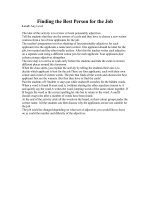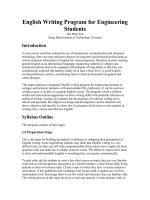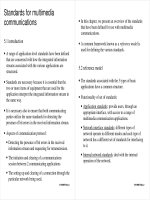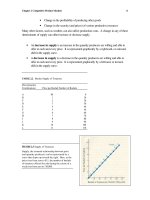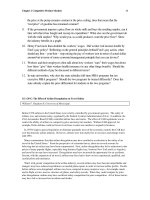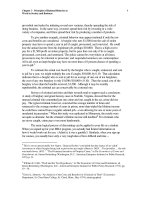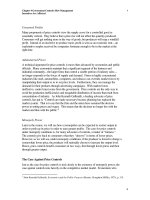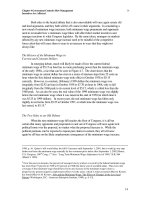Standards for medicines management doc
Bạn đang xem bản rút gọn của tài liệu. Xem và tải ngay bản đầy đủ của tài liệu tại đây (559.06 KB, 67 trang )
Standards for
medicines management
1
Record
keeping
Guidance for nurses
and midwives
15105_Record Keeping_A5_proof 3.indd 1 09/03/2010 09:47
2
We are the nursing and midwifery regulator for England, Wales, Scotland, Northern
Ireland and the Islands.
• We exist to safeguard the health and wellbeing of the public.
• We set the standards of education, training and conduct that nurses and midwives
need to deliver high quality healthcare consistently throughout their careers.
• We ensure that nurses and midwives keep their skills and knowledge up to date
and uphold the standards of their professional code.
• We ensure that midwives are safe to practise by setting rules for their practice and
supervision.
• We have fair processes to investigate allegations made against nurses and
midwives who may not have followed the code.
3
Introduction
The Nursing and Midwifery Council (NMC) is the UK regulator for two professions:
nursing and midwifery. The primary purpose of the NMC is protection of the public.
It does this through maintaining a register of all nurses, midwives and specialist
community public health nurses eligible to practise within the UK and by setting
standards for their education, training and conduct. One of the most important ways of
serving the public interest is through providing advice and guidance to registrants on
professional issues. The purpose of this booklet is to set standards for safe practice in
the management and administration of medicines by registered nurses, midwives and
specialist community public health nurses.
Standards for medicine management replace the Guidelines for the
administration of medicines 2004, although many of its principles remain relevant
today, for example:
“The administration of medicines is an important aspect of the professional practice
of persons whose names are on the Council’s register. It is not solely a mechanistic
task to be performed in strict compliance with the written prescription of a medical
practitioner (can now also be an independent and supplementary prescriber). It
requires thought and the exercise of professional judgement ”
Many government and other agencies are involved in medicines management
from manufacture, licensing, prescribing and dispensing, to administration. As the
administration of a medicinal product is only part of the process, these standards
reecttheprocessfromprescribingthroughtodispensing,storage,administrationand
disposal. There exists an extensive range of guidance on medicines management from
a range of relevant bodies. Sources of information are listed on pages 55–58. One of
the best sources of advice locally is the pharmacist.
As with all NMC standards, this booklet provides the minimum standard by which
practice should be conducted and will provide the benchmark by which practice
is measured. Due to the complexity, speed and extent of change in contemporary
health care, it is not intended to cover every single situation that you may encounter
during your career. Instead, it sets out a series of standards that will enable you to
think through issues and apply your professional expertise and judgement in the best
interests of your patients. It will also be necessary to develop and refer to additional
local and national policies and protocols to suit local needs.
Denitions
Medicinal products
“Any substance or combination of substances presented for treating or preventing
disease in human beings or in animals. Any substance or combination of substances
which may be administered to human beings or animals with a view to making a
medical diagnosis or to restoring, correcting or modifying physiological functions in
human beings or animals is likewise considered a medicinal product.” Council Directive
65/65/EEC.
4
Medicines management
“The clinical, cost-effective and safe use of medicines to ensure patients get the
maximumbenetfromthemedicinestheyneed,whileatthesametimeminimising
potential harm.” (MHRA 2004).
Blood and blood products
Bloodisnotclassiedasamedicinalproductalthoughsomebloodcomponentsare.
Products derived from the plasma component of blood such as blood clotting factors,
antibodiesandalbuminarelicensedandclassiedasconsideredtobemedicinal
products. For the purpose of the administration of medicinal products registrants
would be expected to apply the standards for medicines management to all medicinal
products but should consider additional guidance by the National Patient Safety Agency
– guidance launched on 9 November 2006; Right patient, Right blood (available at
www.npsa.nhs.uk). A key requirement of this guidance is that all staff involved in blood
transfusion undergo formal competency assessment on a three-yearly basis.
Use of the word ‘patient’ throughout the document
Throughout this document where the word ‘patient’ is used this refers to whoever
the medication may be administered to, for example, patient, client, user or woman
(midwifery).
Use of the word ‘registrant’ throughout the document
Throughout this document where the word ‘registrant’ is used this refers to nurses,
midwives and specialist community public health nurses who are registered on the
NMC register.
5
Summary of standards
This section provides a summary of the standards for easy reference. For further detail
you should read, follow and adhere to the standards as detailed later in the document. It
is essential that you read the full guidance.
Section 1
Methods of supplying and/or administration of medicines
Standard 1: Methods
Registrants must only supply and administer medicinal products in accordance with one
or more of the following processes:
• Patientspecicdirection(PSD)
• Patient medicines administration chart (may be called medicines administration
record MAR)
• Patient group direction (PGD)
• Medicines Act exemption
• Standing order
• Homely remedy protocol
• Prescription forms
Standard 2: Checking
Registrants must check any direction to administer a medicinal product.
Standard 3: Transcribing
As a registrant you may transcribe medication from one ‘direction to supply or
administer’ to another form of ‘direction to supply or administer’.
Section 2
Dispensing
Standard 4: Prescription medicines
Registrants may in exceptional circumstances label from stock and supply a clinically
appropriate medicine to a patient, against a written prescription (not PGD), for
self-administration or administration by another professional, and to advise on its safe
and effective use.
6
Standard 5: Patients’ own medicines
Registrants may use patients’ own medicines in accordance with the guidance in this
booklet Standards for medicines management.
Section 3
Storage and transportation
Standard 6: Storage
Registrants must ensure all medicinal products are stored in accordance with the patient
informationleaet,summaryofproductcharacteristicsdocumentfoundindispensed
UK-licensed medication, and in accordance with any instruction on the label.
Standard 7: Transportation
Registrants may transport medication to patients including controlled drugs, where
patients, their carers or representatives are unable to collect them, provided the
registrant is conveying the medication to a patient for whom the medicinal product has
been prescribed, (for example, from a pharmacy to the patient’s home).
Section 4
Standards for practice of administration of medicines
Standard 8: Administration
As a registrant, in exercising your professional accountability in the best interests of
your patients:
• you must be certain of the identity of the patient to whom the medicine is to be
administered
• you must check that the patient is not allergic to the medicine before administering it
• you must know the therapeutic uses of the medicine to be administered, its normal
dosage, side effects, precautions and contra-indications
• you must be aware of the patient’s plan of care (care plan or pathway)
• you must check that the prescription or the label on medicine dispensed is clearly
written and unambiguous
• you must check the expiry date (where it exists) of the medicine to be administered
• you must have considered the dosage, weight where appropriate, method of
administration, route and timing
• you must administer or withhold in the context of the patient’s condition,
(for example, Digoxin not usually to be given if pulse below 60) and co-existing
therapies, for example, physiotherapy
7
• you must contact the prescriber or another authorised prescriber without delay
where contra-indications to the prescribed medicine are discovered, where the
patient develops a reaction to the medicine, or where assessment of the patient
indicates that the medicine is no longer suitable (see Standard 25).
• you must make a clear, accurate and immediate record of all medicine
administered, intentionally withheld or refused by the patient, ensuring the signature
is clear and legible. It is also your responsibility to ensure that a record is made
when delegating the task of administering medicine.
In addition:
• Where medication is not given, the reason for not doing so must be recorded.
• You may administer with a single signature any prescription only medicine (POM),
general sales list (GSL) or pharmacy (P) medication.
In respect of controlled drugs:
• These should be administered in line with relevant legislation and local standard
operating procedures.
• It is recommended that for the administration of controlled drugs a secondary
signatory is required within secondary care and similar healthcare settings.
• In a patient’s home, where a registrant is administering a controlled drug that has
already been prescribed and dispensed to that patient, obtaining a secondary
signatory should be based on local risk assessment.
• Although normally the second signatory should be another registered health care
professional (for example doctor, pharmacist, dentist) or student nurse or midwife,
in the interest of patient care, where this is not possible, a second suitable person
who has been assessed as competent may sign. It is good practice that the second
signatory witnesses the whole administration process. For guidance, go to
www.dh.gov.uk and search for safer management of controlled drugs: guidance on
standard operating procedures.
• In cases of direct patient administration of oral medication from stock in a substance
misuse clinic, it must be a registered nurse who administers, signed by a second
signatory (assessed as competent), who is then supervised by the registrant as the
patient receives and consumes the medication.
• You must clearly countersign the signature of the student when supervising a
student in the administration of medicines.
Standard 9: Assessment
As a registrant, you are responsible for the initial and continued assessment of patients
who are self-administering and have continuing responsibility for recognising and acting
upon changes in a patient’s condition with regards to safety of the patient and others.
8
Standard 10: Self-administration – children and young people
In the case of children, when arrangements have been made for parents or carers or
patients to administer their own medicinal products prior to discharge or rehabilitation,
the registrant should ascertain that the medicinal product has been taken as prescribed.
Standard 11: Remote prescription or direction to administer
In exceptional circumstances, where medication has been previously prescribed and
the prescriber is unable to issue a new prescription, but where changes to the dose are
considered necessary, the use of information technology (such as fax, text message or
email)maybeusedbutmustconrmanychangetotheoriginalprescription.
Standard 12: Text messaging
As a registrant, you must ensure that there are protocols in place to ensure patient
condentialityanddocumentationofanytextreceivedincluding:completetext
message, telephone number (it was sent from), the time sent, any response given, and
the signature and date when received by the registrant.
Standard 13: Titration
Where medication has been prescribed within a range of dosages, it is acceptable for
registrants to titrate dosages according to patient response and symptom control and to
administer within the prescribed range.
Standard 14: Preparing medication in advance
Registrants must not prepare substances for injection in advance of their immediate use
or administer medication drawn into a syringe or container by another practitioner when
not in their presence.
Standard 15: Medication acquired over the internet
Registrants should never administer any medication that has not been prescribed, or
that has been acquired over the internet without a valid prescription.
Standard 16: Aids to support compliance
Registrants must assess the patient’s suitability and understanding of how to use an
appropriate compliance aid safely.
Section 5
Delegation
Standard 17: Delegation
A registrant is responsible for the delegation of any aspects of the administration of
medicinal products and they are accountable to ensure that the patient, carer or care
assistant is competent to carry out the task.
9
Standard 18: Nursing and midwifery students
Students must never administer or supply medicinal products without direct supervision.
Standard 19: Unregistered practitioners
In delegating the administration of medicinal products to unregistered practitioners, it is
the registrant who must apply the principles of administration of medicinal products as
listed above. They may then delegate an unregistered practitioner to assist the patient
in the ingestion or application of the medicinal product.
Standard 20: Intravenous medication
Wherever possible, two registrants should check medication to be administered
intravenously, one of whom should also be the registrant who then administers the
intravenous (IV) medication.
Section 6
Disposal of medicinal products
Standard 21: Disposal
A registrant must dispose of medicinal products in accordance with legislation.
Section 7
Unlicensed medicines
Standard 22: Unlicensed medicines
A registrant may administer an unlicensed medicinal product with the patient’s informed
consentagainstapatient-specicdirectionbutNOTagainstapatientgroupdirection.
Section 8
Complementary and alternative therapies
Standard 23: Complementary and alternative therapies
Registrants must have successfully undertaken training and be competent to practise
the administration of complementary and alternative therapies.
Section 9
Management of adverse events (errors or incidents) in the administration of
medicines
Standard 24: Management of adverse effects
As a registrant, if you make an error you must take any action to prevent any potential
harm to the patient and report as soon as possible to the prescriber, your line manager
or employer (according to local policy) and document your actions. Midwives should
also inform their named supervisor of midwives.
10
Standard 25: Reporting adverse reactions
As a registrant, if a patient experiences an adverse drug reaction to a medication, you
must take any action to remedy harm caused by the reaction. You must record this in
the patient’s notes, notify the prescriber (if you did not prescribe the drug) and notify via
the Yellow Card Scheme immediately.
Section 10
Controlled drugs
Standard 26: Controlled drugs
Registrants should ensure that patients prescribed controlled drugs are administered
these in a timely fashion in line with the standards for administering medication
to patients. Registrants should comply with and follow the legal requirements and
approved local standard operating procedures for controlled drugs that are appropriate
for their area of work.
11
Contents
Standards
Section 1: Method of supplying and/or administration of medicines
Standard 1: Methods 13
Standard 2: Checking 18
Standard 3: Transcribing 18
Section 2: Dispensing
Standard 4: Prescription medicines 20
Standard 5: Patients’ own medicines 20
Section 3: Storage and transportation
Standard 6: Storage 22
Standard 7: Transportation 23
Section 4: Standards for practice of administration of medicines
Standard 8: Administration 24
Standard 9: Assessment 26
Standard 10: Self-administration – children and young people 28
Standard 11: Remote prescription or direction to administer 28
Standard 12: Text messaging 30
Standard 13: Titration 30
Standard 14: Preparing medication in advance 30
Standard 15: Medication acquired over the internet 31
Standard 16: Aids to support compliance 32
Section 5: Delegation
Standard 17: Delegation 33
Standard 18: Nursing and midwifery students 33
Standard 19: Unregistered practitioners 33
Standard 20: Intravenous medication 34
Section 6: Disposal of medicinal products
Standard 21: Disposal 35
Section 7: Unlicensed medicines
Standard 22: Unlicensed medicines 35
Section 8: Complementary and alternative therapies
Standard 23: Complementary and alternative therapies 36
Section 9: Management of adverse events (errors or incidents) in the
administration of medicines
Standard 24: Management of adverse events 37
Standard 25: Reporting adverse reactions 38
Section 10: Controlled drugs
Standard 26: Controlled drugs 38
12
Annexes
Annexe 1
Legislation
Annexe 2
Guidance on labelling and over-labelling of medicines
Annexe 3
Suitability of patients’ own medicinal products for use
Annexe 4
Exclusion criteria for self-administration medicines
Annexe 5
Administering medicinal products in research clinical trials
Annexe 6
Information and publications
Annexe 7
Glossary
Annexe 8
Contributors
13
The standards: Section 1
Methods of supplying and/or administration of medicines
Methods to enable nurses, midwives and specialist community public health nurses to
supply and/or administer may include the following:
Standard 1: Methods
1 Registrants must only supply and administer medicinal products in accordance with
one or more of the following processes:
1.1 Patient-specicdirection(PSD)
1.2 Patient medicines administration chart (may be called a medicines
administration record (MAR))
1.3 Patient group direction (PGD)
1.4 Medicines Act Exemption (where they apply to nurses)
1.5 Standing order
1.6 Homely remedy protocol
1.7 Prescription forms
2 Once a medicinal product has been prescribed and dispensed to an individual,
the drug is the individual’s own property. To use it for someone else is theft .
Registrants should refer to DH (2006) Medicines Matters: A guide to mechanisms
for the prescribing, supply and administration of medicines.
Patient-specic direction (PSD)
3 Apatient-specicdirection(PSD)isawritteninstructionfromaqualiedand
registered prescriber for a medicine including the dose, route and frequency or
appliance to be supplied or administered to a named patient. In primary care, this
might be a simple instruction in the patient’s notes. Examples in secondary care
include instructions on a patient’s medicines administration chart. The direction
wouldneedtobespecicastotherouteofadministrationitcannotsimplyauthorise
a course of treatment to several patients. Where a PSD exists, there is no need for
a patient group direction.
4 EachindividualpatientmustbeidentiedonthePSD.AnexampleofusingaPSD
is in the administration of routine vaccine where a list of patients due a vaccine may
beidentiedbeforehand.Inthecaseofcontrolleddrugs,itisessentialtocomply
with full prescription requirements. Go to www.dh.gov.uk and search for controlled
drugs.
14
Patient medicines administration chart
5 The patient medicines administration chart is not a prescription but a direction to
administer medication. It must be signed by a registered prescriber and authorises
the delegation to administer medication on the prescriber’s behalf. However, in
doing so the registrant is accountable for their actions and for raising any concerns
about the direction with the prescriber, for example, in respect to clarity.
Patient group direction (PGD)
6 Patientgroupdirections(PGDs)arespecicwritteninstructionsforthesupplyor
administrationofalicensednamedmedicineincludingvaccinestospecicgroups
ofpatientswhomaynotbeindividuallyidentiedbeforepresentingfortreatment.
Guidance on the use of PGDs is contained within Health Service Circular (HSC)
2000/026.
7 SeeHomeOfcecircular049/2003.Controlled Drugs Legislation – Nurse
Prescribing And Patient Group Directions. Go to www.dh.gov.uk and search for
controlled drugs.
8 Guidance has also been issued in Wales (WHC 2000/116), and in Scotland and
Northern Ireland.
9 ThecircularalsoidentiesthelegalstandingofPGDsplusadditionalguidanceon
drawing them up and operating within them. It is vital that anyone involved in the
delivery of care within a PGD is aware of the legal requirements. PGDs are not a
form of prescribing.
10 PGDs are drawn up locally by doctors, dentists, pharmacists, and other health
professionals where relevant. They must be signed by a doctor or dentist and a
pharmacist, both of whom should have been involved in developing the direction,
and must be approved by the appropriate health care organisation. The NMC would
consider it good practice that a lead practitioner from the professional group using
the PGD and senior manager where possible, are also involved and sign off a PGD.
11 PGDs can be used by independent providers for NHS commissioned services. As
medicines legislation does not apply outside the UK, a PGD would not be required
– for example – on cruise ships. However, the NMC would consider it good practice
for such bodies to develop protocols using PGD templates that are signed off by a
doctor, dentist, pharmacist, other health professionals where relevant and a senior
manager where possible.
12 PGDs should only be used once the registrant has been assessed as competent
andwhosenameisidentiedwithineachdocument.Theadministrationofdrugsvia
a PGD may not be delegated. Students cannot supply or administer under a PGD
but would be expected to understand the principles and be involved in the process.
Where medication is already subject to exemption order legislation there is no
requirement for a PGD.
15
13 When supplying under PGD, this should be from the manufacturer’s original
packs or over-labelled pre-packs so that the patient details, date and additional
instructions can be written on the label at the time of supply. Registrants must not
split packs. For more information on labelling see annexe 2.
14 See To PGD or not to PGD at:
www.portal.nelm.nhs.uk/PGD/viewRecord.aspx?recordID=422
15 PGDs in the NHS:
www.mhra.gov.uk/home/idcplg?IdcService=SS_GET_PAGE&nodeId=148
16 PGDs in the private sector:
www.mhra.gov.uk/home/idcplg?IdcService=SS_GET_PAGE&nodeId=147
Medicines Act Exemptions
17 Allow certain groups of healthcare professionals including occupational health
nurses under occupational health schemes and midwives to sell, supply and
administerspecicmedicinesdirectlytopatientandclients.
17.1 Provided the requirements of any conditions attached to those exemptions are
met, a PGD is not required.
17.2 Registrants must work to locally agreed written protocols and procedures, and
maintain auditable records.
17.3 Occupational health nurses that offer services, for example, open access
travel clinics outside of occupational health schemes must comply with
guidance from the appropriate regulator.
18 Registrants may only supply and administer under an exemption order where the
order pertains to them. Where nurses are working as emergency care practitioners
within an ambulance service they may not supply and administer under paramedic
exemptions unless they are also registered as a paramedic with the Health
Professions Council – to do so would contravene medicine legislation and the
employer’s vicarious liability would not apply.
19 Search for NMC Circular 1/2005 Medicine legislation: what it means for midwives at
www.nmc-uk.org
Standing orders
20 In the past, maternity service providers and occupational health schemes have
produced local guidelines, often referred to as ‘standing orders’, to supplement the
legislation on the medicinal products that practising midwives and occupational
health nurses may supply and/or administer. These guidelines are not a prerequisite
underanylegislation.Thereisnolegaldenitionforstandingordersandthis
term does not exist in any medicines legislation. The NMC would consider it good
practice where midwives and occupational health nurses are using standing orders
for medicinal products that are not covered by Medicines Act Exemptions that these
should be converted to PGDs.
16
Homely remedy protocols
21 Homely remedy protocols cannot be used for prescription only medicines including
controlled drugs. These must be supplied and administered under a PSD, a
prescription or a PGD.
Guidance
22 Homely remedy protocols are not prescriptions but protocols to enable
administration of general sales list (GSL) and pharmacy only (P) listed medicines
in settings, for example, care homes, children’s homes and some educational
institutions. Although they have no legal standing they are required for liability
purposes. Any registrant using a homely remedy protocol must ensure there
is a written instruction that has been drawn up and agreed in consultation
withotherrelevantqualiedprofessionals.(Wherepossiblethisshouldbea
medical practitioner or pharmacist.) The protocol should clarify what medicinal
product may be administered and for what indication it may be administered,
the dose, frequency and time limitation before referral to a GP. An example of a
homely remedy could be paracetamol for a headache. All registrants using the
protocolshouldbenamedandtheyshouldsigntoconrmtheyarecompetentto
administer the medicinal product, acknowledging they will be accountable for their
actions.
23 The NMC considers it good practice that the employing organisation signs off all
protocols.
Prescription forms
24 NHSprescriptionformsareclassiedassecurestationery.Prescriptionformsare
serially numbered and have anticounterfeiting and anti-forgery features. Within
the NHS they are purchased by primary care trusts (PCTs), hospital boards
and hospitals via a secure ordering system, and distributed free. The range of
prescription forms used by registered prescribers can be found in each UK country
government website.
25 Speciccontrolleddrugprescriptionformsareavailablefromthelocalhealthcare
organisation, for example, PCT, LHB, for use in the private healthcare sector.
Speciccontrolleddrugprescriptionsareusedfortreatmentofaddictionandfor
private prescriptions for controlled drugs. Only the designated prescription form
should be used. Detailed guidance on how to complete prescription forms, including
special requirements when prescribing controlled drugs, is available from the
DepartmentofHealth(DH),HealthCareCommission(HCC),HomeOfce,the
Prescription Prices Division of the NHS Business Services Authority website and
in the BNF. The Regulation and Quality Improvement Authority is equivalent to
the HCC in Northern Ireland. Registrants in Northern Ireland should access their
website for up-to-date information on their standards.
www.npc.co.uk/controlled_drugs/CDGuide_2ndedition_February_2007.pdf
26 For the Welsh Health circular, go to:
www.wales.nhs.uk/documents/WHC_2006_018.pdf
17
27 SearchfortheHomeOfceCircularControlledDrugsLegislation–Nurse
Prescribing and Patient Group Directions at:
www.knowledgenetwork.gov.uk/HO/circular.nsf
Who may write a prescription?
28 Anyqualiedandregisteredindependentprescribermayprescribeallprescription
only medicines for all medical conditions. In addition, nurse independent prescribers
may also prescribe some controlled drugs.
29 Supplementary prescribers may prescribe in accordance with a clinical
management plan (CMP) in a tripartite arrangement with a doctor or dentist, the
patient and the supplementary prescriber. A supplementary prescriber, when acting
under and in accordance with the terms of a CMP, may administer and supply or
direct any person to administer controlled drugs in schedules 2, 3, 4 and 5, and
can prescribe unlicensed medicinal products. Please see section 5 of this document
on delegation.
Prescribing by nurses, midwives and specialist community public health nurses
30 The Medicinal Products: Prescription by Nurses Act 1992 and subsequent
amendments to the pharmaceutical services regulations allow nurses and
midwives,whohaverecordedtheirqualicationontheNMCregister,tobecome
nurse or midwife prescribers. There are two levels of nurse and midwife prescribers:
Community practitioner nurse prescribers
30.1 These are registrants who have successfully undertaken a programme of
preparation to prescribe from Community Practitioner Nurse Prescribers’
Formulary. They can prescribe the majority of dressings and appliances,
and a limited range of prescription only medicines. The Community Nurse
Prescribers’ Formulary can be found on the British National Formulary
website. Go to: www.bnf.org
Independent and supplementary nurse and midwife prescribers
30.2 These are nurses and midwives who are trained to make a diagnosis and
prescribe the appropriate treatment (independent prescribing). They may also,
in cases where a doctor has made an initial diagnosis, go on to prescribe or
review the medication, and change the drug, dosage, timing or frequency or
route of administration of any medication as appropriate as part of a clinical
management plan (supplementary prescribing).
31 Nurse or midwife independent prescribers can prescribe all prescription only
medicines including some controlled drugs, and all medication that can be supplied
by a pharmacist or bought over the counter. They must only prescribe drugs
that are within their area of expertise and level of competence, and should only
prescribe for children if they have the expertise and competence to do so.
18
32 Nurse, midwife and specialist community public health nurse prescribers must
comply with current prescribing legislation and are accountable for their practice.
33 For Department of Health guidance go to www.dh.gov.uk and search: nurse
independent prescribing.
Standard 2: Checking
1 Registrants (1st and 2nd level) must check any direction to administer a medicinal
product.
2 As a registrant you are accountable for your actions and omissions. In administering
any medication, or assisting or overseeing any self-administration of medication,
you must exercise your professional judgement and apply your knowledge and skill
in the given situation. As a registrant, before you administer a medicinal product you
must always check that the prescription or other direction to administer is:
2.1 not for a substance to which the patient is known to be allergic or otherwise
unable to tolerate
2.2 based, whenever possible, on the patient’s informed consent and awareness of
the purpose of the treatment
2.3 clearly written, typed or computer-generated and indelible
2.4 speciesthesubstancetobeadministered,usingitsgenericorbrandname
where appropriate and its stated form, together with the strength, dosage,
timing,frequencyofadministration,startandnishdates,androuteof
administration
2.5 is signed and dated by the authorised prescriber
2.6 inthecaseofcontrolleddrugs,speciesthedosageandthenumberofdosage
units or total course; and is signed and dated by the prescriber using relevant
documentation as introduced, for example, patient drug record cards.
3 And that you have:
3.1 clearlyidentiedthepatientforwhomthemedicationisintended
3.2 recorded the weight of the patient on the prescription sheet for all children,
and where the dosage of medication is related to weight or surface area
(for example, cytotoxics) or where clinical condition dictates recorded the
patient’s weight.
Standard 3: Transcribing
1 As a registrant you may transcribe medication from one ‘direction to supply or
administer’ to another form of ‘direction to supply or administer’.
19
Guidance
2 This should only be undertaken in exceptional circumstances and should not be
routine practice. However, in doing so you are accountable for your actions and
omissions. Any medication that you have transcribed must be signed off by a
registered prescriber. In exceptional circumstances this may be done in the form
of an email, text or fax before it can be administered by a registrant.
3 Any act by which medicinal products are written from one form of direction to
administer to another is transcribing. This includes, for example, discharge letters,
transfer letters, copying illegible patient administrations charts onto new charts,
whether hand-written or computer-generated.
4 When medicine administration records in a care home are hand-written by a
registrant, they may be transcribed from the details included on the label attached
to the dispensed medicine. However, in doing so the registrant must ensure that
the charts are checked by another registrant where possible, and where not,
another competent health professional.
5 The registrant is accountable for what they have transcribed.
6 Managers and employers are responsible for ensuring there is a rigorous policy
for transcribing that meets local clinical governance requirements.
7 As care is being increasingly provided in more ‘closer to home’ settings that are
often nurse-led, managers and employers should undertake a risk assessment
involving registrants, pharmacists and responsible independent prescribers to
develop a management process to enable transcribing to be undertaken where
necessary. It should not be routine practice. Any transcription must include the
patient’s full name, date of birth, drug, dosage, strength, timing, frequency and
route of administration.
8 Transposing is the technical term used by pharmacists for transcribing.
9 Registrants are advised to read the Health Care Commission guidance for the
transcribing of prescribed medicines for individuals on admission to children’s
hospices. The principles apply to all settings. Go to www.cqc.org.uk. Registrants in
Northern Ireland should refer to the Regulation and Quality Improvement Authority
website at www.rqia.org.uk
20
The standards: Section 2
Dispensing
Standard 4: Prescription medicines
1 Registrants may in exceptional circumstances label from stock and supply a
clinically appropriate medicine to a patient, against a written prescription (not PGD),
for self-administration or administration by another professional, and to advise on its
safe and effective use.
Guidance
2 Thedenitionofdispensingis“Tolabelfromstockandsupplyaclinically
appropriate medicine to a patient, client or carer, usually against a written
prescription, for self-administration or administration by another professional, and
to advise on safe and effective use”. (MHRA, 2006)
3 Dispensing includes such activities as checking the validity of the prescription, the
appropriateness of the medicine for an individual patient, assembly of the product,
labellinginaccordancewithlegalrequirementsandprovidinginformationleaets
for the patient.
4 If under exceptional circumstances you, as a registrant, you are engaged in
dispensing, this represents an extension to your professional practice. There is no
legal barrier to this practice. However, this must be in the course of the business
of a hospital, and in accordance with a registered prescriber’s written instructions
and covered by a standard operating procedure (SOP). In a dispensing doctor’s
practice, registrants may supply to patients under a particular doctor’s care, when
acting under the directions of a doctor from that practice. The patient has the legal
right to expect that the dispensing will be carried out with the same reasonable
skill and care that would be expected from a pharmacist.
Standard 5: Patients’ own medicines
1 Registrants may use patients’ own medicines in accordance with the guidance in
this booklet Standards for medicines management.
2 The NMC welcomes and supports the self-administration of medicinal products and
the administration of medication by carers wherever it is appropriate.
The use of patients’ own medicinal products in any setting
3 Where patients have their own supply of medicinal products, whether prescribed,
over the counter (from a pharmacy, supermarket or shop), complementary therapy,
herbal preparation or homely remedy such as paracetamol, the registrant has a
responsibility to:
3.1 ask to see the medicinal products
3.2 check for suitability of use
21
3.3 explain how and why they will or won’t be used
3.4 establish if they are prescribed
3.5 ascertain if they meet the criteria for use.
4 These medicinal products including controlled drugs remain the patient’s property
and must not be removed from the patient without their permission and must only
be used for that named individual.
5 The registrant has a responsibility to document in the patient’s notes when a patient
refuses consent:
5.1 to use their own medicines
5.2 to dispose of their own medicinal products no longer required
5.3 to dispose of their own medicinal products not suitable for use
5.4 when in the hospital or care home setting to send their own medicinal products
home with a relative or carer
Storage of patients’ own medicinal products
6 As a registrant you have the following responsibilities:
6.1 to ensure that suitable facilities are provided to store patients’ own medicinal
products for their safe storage
6.2 to assess patients on a regular basis using local polices to ensure that the
individual patient is still able to self-administer
6.3 to document issues relating to storage in their records
6.4 that the medicines cabinet or locker is kept locked and that the master key is
kept secure
6.5 that if the patient is self-administering, consent is obtained from the patient to
keep the individual medicines cabinet/locker locked and the key secure with the
patient
6.6 that if a patient moves to another bed, to another ward or room or is
discharged, the patient’s medicinal products are transferred with the patient
6.7 In a hospital setting, best practice indicates that stock medicines should not be
placed in the patient’s locked cabinet or locker as they are not labelled for that
individual patient.
22
Administering medicines using the patient’s own supply in the hospital or care
home setting
7 When administering medicines from the patient’s own supply, the registrant must
check the medicines in the locked cabinet or locker with the prescription chart and
use only those medicines belonging to that named patient.
8 If a supply is not available, medicines belonging to another patient must not be
used.
9 For further guidance on the use of patients’ own medicinal products including
discharge and checking medications to take home (TTOs) see annexe 3. For
self-administration of medicines see standard 9 of this document
Self-administration of medicines.
One-stop dispensing
10 In some hospitals a system of one-stop dispensing is in operation and local policies
should be developed for this using the guidance for patients’ own medicinal
products as stated under standard 5 of this document.
Guidance
11 One-stop dispensing is a system of administering and dispensing medicinal
products adopted in hospitals throughout the UK (Audit Commission Report:
A Spoonful of Sugar 2002 – The Right Medicine (Scottish Executive 2002). It
involves using the patient’s own medicinal products during their stay in hospital,
either those dispensed by a community pharmacy or by the hospital pharmacy or
both,providingtheycontainapatientinformationleaetandarelabelledwithfull
instructions for use. Supplies are replenished should the supply run out whilst in
hospital or when any new items are prescribed. Patients are discharged with a
supply of medicinal products as agreed locally.
12 In one-stop dispensing, medicinal products are dispensed once only on or during
admission ready for discharge. Registrants should check that the medication
handed to the patient on discharge is as per the discharge prescription, as
medicines may be altered or stopped during hospital admission. If a particular
medicine has been stopped during admission and is not to be restarted on
discharge, the patient must be informed. The ward pharmacist is a useful
resource for advice.
The standards: Section 3
Storage and transportation
Standard 6: Storage
1 Registrants must ensure all medicinal products are stored in accordance with the
patientinformationleaet,summaryofproductcharacteristicsdocumentfound
in dispensed UK-licensed medication and in accordance with any instruction on
the label.
23
Guidance
2 Thepatientinformationleaetorsummaryofproductcharacteristicsdocumentfor
UK-licensed medicinal products may be found at www.emc.medicines.org.uk.
Policies should be in place to ensure all storage environments meet the required
standards and it is the responsibility of the registrant to check such policies are
in place and are being adhered to. This is particularly important for medicines
requiring storage within a limited temperature range, for example, refrigeration
of vaccines when maintenance of the cold chain has to be considered during
transfer for school sessions or administration in the patient’s home.
Go to www.the-shipman-inquiry.org.uk/4r_page.asp?id=3119
Standard 7: Transportation
1 Registrants may transport medication to patients including controlled drugs (CDs),
where patients, their carers or representatives are unable to collect them, provided
the registrant is conveying the medication to a patient for whom the medicine has
been prescribed (for example, from a pharmacy to the patient’s home).
Guidance
2 However, it is considered good practice that registrants should not routinely
transport CDs in the course of their practice. This should only be undertaken in
circumstances where there is no other reasonable mechanism available. All drugs
should be kept out of sight during transportation.
3 When collecting CDs from a pharmacy, the registrant will be asked to sign for
them and prove identity in the form of their professional identity badge or Pin
(where self-employed). Midwives must be familiar with the use of midwives supply
orders. Go to NMC Circular 25/2005whichyoucanndatwww.nmc-uk.org/
publications. It is anticipated as a recommendation from the Shipman Inquiry
Fourth Report that new documentary evidence will be required in the form of
a patient drug record card. Registrants would be expected to be aware of and
comply with any new legislation and guidance introduced.
The standards: Section 4
Standards for practice of administration of medicines
1 Having initially checked the direction to supply or administer that a medicinal
product is appropriate for your patient or client (standard 2) you may then
administer medication.
24
Standard 8: Administration
2 As a registrant, in exercising your professional accountability in the best interests of
your patients:
2.1 you must be certain of the identity of the patient to whom the medicine is to be
administered
2.2 you must check that the patient is not allergic to the medicine before
administering it
2.3 you must know the therapeutic uses of the medicine to be administered, its
normal dosage, side effects, precautions and contra-indications
2.4 you must be aware of the patient’s plan of care (care plan or pathway)
2.5 you must check that the prescription or the label on medicine dispensed is
clearly written and unambiguous
2.6 you must check the expiry date (where it exists) of the medicine to be
administered
2.7 you must have considered the dosage, weight where appropriate, method of
administration, route and timing
2.8 you must administer or withhold in the context of the patient’s condition (for
example, Digoxin not usually to be given if pulse below 60) and co-existing
therapies, for example, physiotherapy
2.9 you must contact the prescriber or another authorised prescriber without delay
where contra-indications to the prescribed medicine are discovered, where
the patient develops a reaction to the medicine, or where assessment of the
patient indicates that the medicine is no longer suitable (see standard 25)
2.10 you must make a clear, accurate and immediate record of all medicine
administered, intentionally withheld or refused by the patient, ensuring the
signature is clear and legible; it is also your responsibility to ensure that a
record is made when delegating the task of administering medicine.
In addition:
3 Where medication is not given, the reason for not doing so must be recorded.
4 You may administer with a single signature any prescription only medicine, general
sales list or pharmacy medication.
In respect of controlled drugs:
5 These should be administered in line with relevant legislation and local standard
operating procedures.
6 It is recommended that for the administration of controlled drugs, a secondary
signatory is required within secondary care and similar healthcare settings.
25
7 In a patient’s home, where a registrant is administering a controlled drug that has
already been prescribed and dispensed to that patient, obtaining a secondary
signatory should be based on local risk assessment.
8 Although normally the second signatory should be another registered health care
professional (for example doctor, pharmacist, dentist) or student nurse or midwife,
in the interest of patient care, where this is not possible a second suitable person
who has been assessed as competent may sign. It is good practice that the second
signatory witnesses the whole administration process. For guidance, go to
www.dh.gov.uk and search for Safer Management of Controlled Drugs: Guidance
on Standard Operating Procedures.
9 In cases of direct patient administration of oral medication, for example, from stock
in a substance misuse clinic, it must be a registered nurse who administers, signed
by a second signatory (assessed as competent), who is then supervised by the
registrant as the patient receives and consumes the medication.
10 You must clearly countersign the signature of the student when supervising a
student in the administration of medicines.
11 These standards apply to all medicinal products.
Guidance
Assessing competence to support a patient in taking their medication
12 A policy must be in place and adhered to in assessing the competence of an
individual to support a patient in taking medication. A record of the individual’s
training and assessment should be kept, and all refresher or continuing education
and training should also be routinely kept.
13 Theregistrantdelegatingshouldbesatisedthattheindividualhasanappropriate
level of education and training and has been assessed as competent. Where this
is not the case, the registrant may refuse to delegate, even when requested to
do so by another health professional. The registrant is accountable for her own
actions including delegation.
Clarifying identity
14 Wheretherearedifcultiesinclarifyinganindividual’sidentity,forexample,insome
areas of learning disabilities, patients with dementia or confusional states, an
up-to-date photograph should be attached to the prescription chart(s). For patients
with burns where the wearing of a wristband is inappropriate and a photograph
would not resemble the patient, local policies should be in place to ensure all staff
arefamiliarwiththepatientsandasystemofidenticationisinplace.Registrants
are responsible for ensuring the photograph remains up to date.
